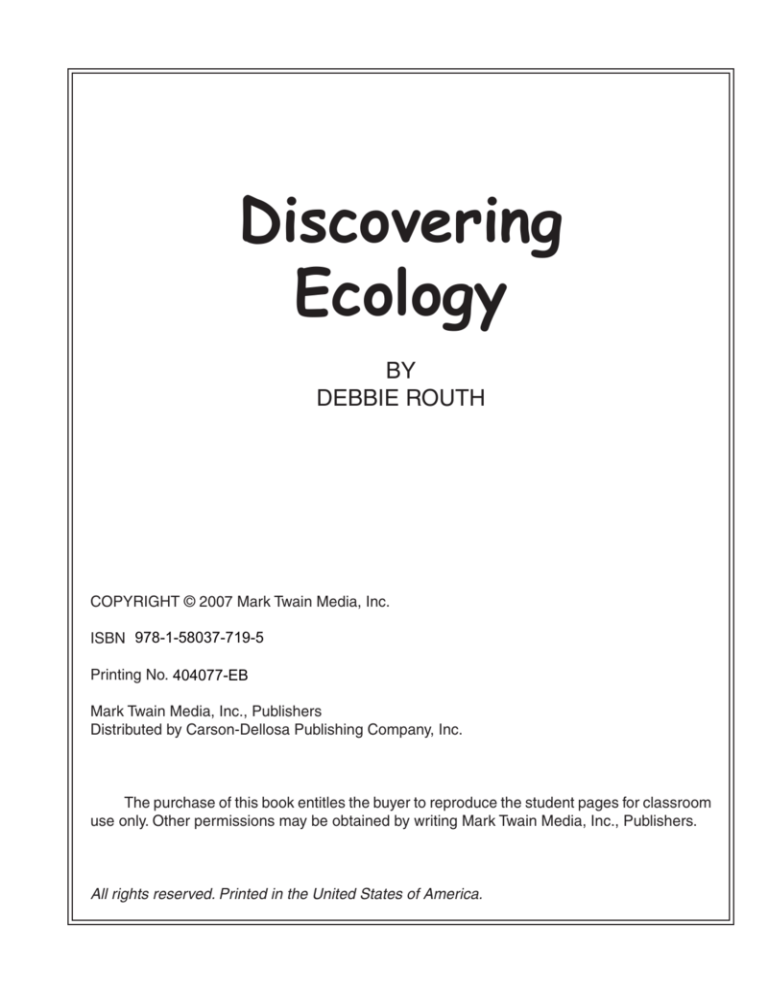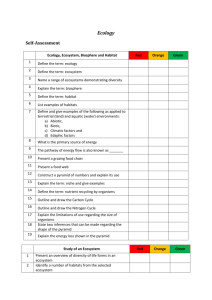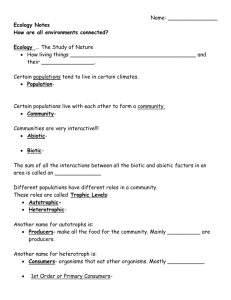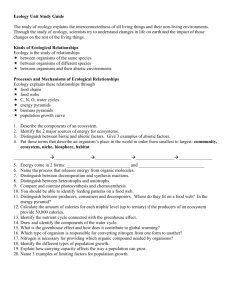
Discovering
Ecology
BY
DEBBIE ROUTH
COPYRIGHT © 2007 Mark Twain Media, Inc.
978-1-58037-719-5
ISBN 978-1-58037-429-3
Printing No. CD-404077
404077-EB
Mark Twain Media, Inc., Publishers
Distributed by Carson-Dellosa Publishing Company, Inc.
The purchase of this book entitles the buyer to reproduce the student pages for classroom
use only. Other permissions may be obtained by writing Mark Twain Media, Inc., Publishers.
All rights reserved. Printed in the United States of America.
Table of Contents
Discovering Ecology
Table of Contents
Introduction................................................................................................................................1
What Is Ecology?.......................................................................................................................2
What Is an Ecosystem?.............................................................................................................4
Learning About the Web of Life.................................................................................................7
Round and Round We Go: Cycles in the Ecosystem..............................................................10
Habitat Activity.........................................................................................................................13
What Are Biomes?...................................................................................................................14
Lake Victoria and the Miracle Fish: Introduction of a New Species.........................................18
Is There Room for One More?: Carrying Capacity..................................................................21
Changes in Our Ecosystems...................................................................................................24
The Ozone Layer and the Greenhouse Effect.........................................................................27
Learning About Pollution.........................................................................................................30
Keeping the Planet Healthy.....................................................................................................33
Research Activity: Alternatives to Fossil Fuels........................................................................36
Ecology: Vocabulary................................................................................................................37
Ecology: Word Search.............................................................................................................38
Ecology: Crossword Puzzle.....................................................................................................39
Ecology Projects......................................................................................................................40
Ecology Unit Test.....................................................................................................................42
Answer Keys............................................................................................................................44
© Mark Twain Media, Inc., Publishers
ii
What Is Ecology?
Discovering Ecology
What Is Ecology?
Ecology (ee-KAHL-uh-jee) is the study of living things in their environment (in-VY-runmunt), or natural surroundings. This is everything biotic (living) and abiotic (nonliving) that
is around them. All living things are affected by their environment and have an effect on their
environment. The word ecology came from the Greek word okologie, meaning the study of
homes and estates. This refers to the home or surroundings in which an organism (living thing)
lives. A German naturalist, Ernst H. Haeckel, was the first person to use the term in its present
meaning. An ecologist is a scientist who studies the relationships between living things and
their environment. An ecologist investigates how plants and animals, including people, live with
and affect each other and their surroundings.
The Biosphere
The part of the earth that supports life is called the biosphere. The top portion of the
earth’s crust, all the water on the earth’s surface, and the surrounding atmosphere make up
the very thin layer called the biosphere. All the different environments that are home to different
kinds of organisms are found in the biosphere.
Importance
All living things need materials to carry out their life processes. These materials come
from the environment. Organisms get nutrients, water, oxygen, carbon dioxide, and energy
from their environments. Nutrients (NOO-tree-unts) are used for growth, repair, and energy.
Plants get their nutrients and water from the soil. Plants take in carbon dioxide from the air.
They obtain energy directly from the sun. Sunlight is the source of energy that fuels most
life on Earth. They then use sunlight and carbon dioxide to make food for energy. Animals
get nutrients and energy by eating plants. Some animals also obtain energy by eating other
animals. Many animals get their oxygen from the air. Aquatic animals with gills get their oxygen
from the water. Water is a key component allowing organisms to process these materials from
the environment. All living things need and use water.
Interactions
Start with any habitat (natural home) of an organism. The group of animals and plants
that live there make up a community. Lift up a stone, and you will most likely find a spider,
centipede, woodlouse, or earthworm. These are all a part of the stone
habitat. Together, they make a community. The stone may lie
next to a pond and become a part of the pond community. The pond may be in a
forest and be part of the woodland community. Smaller habitats are usually a part
of bigger habitats. A different community lives in each larger habitat. The organisms
interact or act upon each other and the nonliving parts of the environment. Waste
that is produced by the animals enriches the soil. This helps the plants grow and thrive in the
community. As you see, observers, everything is connected and stretches into a vast web.
When the community is healthy, it is stable and balanced. You can try to find some different
habitats in your area. Be sure to look everywhere, and leave everything the way you found it.
© Mark Twain Media, Inc., Publishers
What Is Ecology?
Discovering Ecology
Name:
Date:
What Is Ecology?: Reinforcement Activity
To the student observer: Can you list some ways you affect your environment?
Analyze: Can you identify the various environments that make up your everyday life?
Completion: Write the term that best completes each statement in the space provided.
environment
materials
carbon dioxide nutrients
community
abiotic ecology
biotic
habitat
interact
biosphere
plants
1. The study of living things and their environment is
.
2. Everything that surrounds a living thing makes up its
3. Living things get the
.
they need to survive from their
environment.
4. Animals get their energy by eating
and other animals.
5. Plants use sunlight and
to grow and make food.
6. Living things use materials called
for growth and energy.
7. All living things act upon, or
with, their environments.
8. The
factors are the living things in the environment.
9. The
factors are the nonliving things in the environment.
10. The part of the earth that supports life is the
11. A
is the natural home of an organism.
12. All the organisms that live in an area make up a
Think About It:
Can you list five things all living things get from their environments?
1.
2.
3.
4.
5.
© Mark Twain Media, Inc., Publishers
.
.
What Is an Ecosystem?
Discovering Ecology
What Is an Ecosystem?
An ecosystem consists of a given habitat and its community. A community is all the
populations living in a certain place. A population is all of the same kind of organisms living in
that certain place. The living (biotic) and nonliving (abiotic) things in an environment together
with their interactions make up the ecosystem. The habitat and all the interactions going on
inside form a self-contained ecological unit.
Populations
A population is all of the same kind
of organism living in a certain place. Different
populations may live in the same environment.
Study or visualize a pond near your home. Are
there different organisms that live in the pond?
Do you see frogs and toads? Maybe you see a
few cattails, some fish, and overhead you hear
ducks as they come in for a fantastic landing.
There are 5 toads, 10 frogs, 20 minnows, 15
catfish, 10 blue gill, 6 ducks, and a lot of cattails.
The five toads make up one population within
the community. The 15 catfish make up another
population in the community. What is the duck population of the pond community? If you could
get a microscope and a drop of the pond water, you would see many other microorganisms
(tiny living things) living in the pond community.
Communities All the different populations living together and reacting in the habitat make up a unique
community. Organisms interact with each other and the other things in the environment. There
are many kinds and sizes of ecosystems. A rotting log, puddle of water, or even something as
big as a desert can be an ecosystem. All ecosystems must be able to support all the organisms
that live in or on that habitat. To support organisms, these four processes must occur:
1. The production of energy is one process that must occur inside the community. The sun
is a source of energy in most ecosystems.
2. Energy must be transferred to plants that make their own food. The stored energy then is
passed on to animals when they eat the plants.
3. When organisms die, they must decay, or break down, so that other living things can
reuse these nutrients (raw materials).
4. This decomposition of dead materials is then recycled. As the materials break down, they
return to the soil and are reused over and over.
© Mark Twain Media, Inc., Publishers








